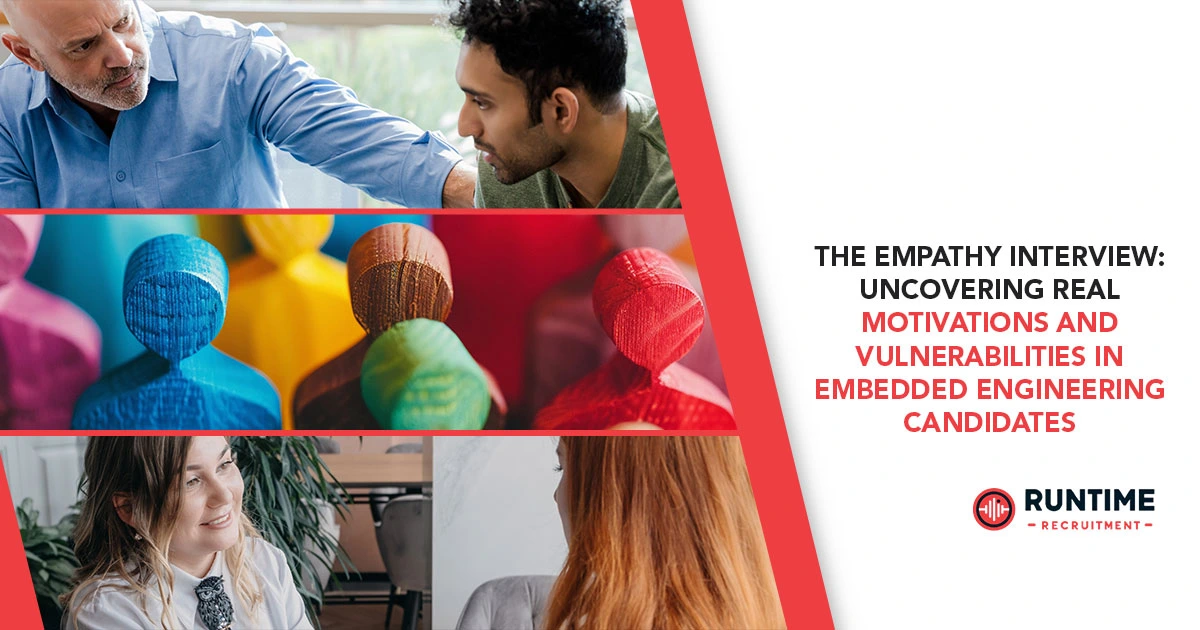Finding the right embedded engineer is like searching for a specific, high-precision component for a complex system. It’s not just about technical specifications; it’s about fit, drive, and the less tangible qualities that contribute to a team’s success and a project’s longevity. In our world of intricate hardware and sophisticated software, the traditional technical interview, while essential, often falls short. It can confirm skill, but it rarely reveals the true motivations that fuel an engineer’s passion or the vulnerabilities that, if understood, can be transformed into strengths.
This is where the Empathy Interview comes in. It’s a powerful, often overlooked, approach that shifts the focus from “what can you do?” to “who are you as an engineer, and what truly drives you?” For embedded systems, where precision, problem-solving under pressure, and collaborative effort are paramount, understanding these deeper aspects of a candidate is not just a nice-to-have; it’s a strategic imperative.
Beyond the Buzzwords: Why Empathy Matters in Embedded Engineering Recruitment
Embedded engineering is a field demanding meticulous attention to detail, relentless debugging, and a deep understanding of constraints – both technical and practical. A candidate might ace a coding challenge or flawlessly explain a state machine, but if they lack the intrinsic motivation to see a project through countless iterations, or if their approach to failure is to hide it rather than learn from it, they could become a bottleneck.
Empathy in the interview process isn’t about being “soft.” It’s about being strategic. It’s about creating an environment where a candidate feels safe enough to reveal their authentic self, allowing you to gauge:
- Intrinsic Motivation: What genuinely excites them about embedded systems? Is it the challenge of optimizing for low power, the satisfaction of seeing hardware come to life, or the elegance of a well-architected firmware?
- Resilience and Learning from Failure: How do they cope when things inevitably go wrong (and in embedded, they always do)? Do they see errors as insurmountable obstacles or as opportunities for growth?
- Collaboration and Team Dynamics: How do they interact with others, especially under pressure? Are they open to feedback, willing to teach, and eager to learn?
- Problem-Solving Philosophy: Beyond just solving a problem, what is their approach to understanding its root cause, exploring alternatives, and anticipating future issues?
- Career Aspirations and Alignment: Do their long-term goals align with the opportunities your company can provide, ensuring mutual satisfaction and retention?
Without an empathetic approach, you risk hiring a technically proficient individual who is a poor cultural fit, lacks genuine drive, or struggles with the inherent challenges of embedded development. This can lead to increased turnover, project delays, and a drain on team morale.
Setting the Stage: Cultivating a Safe and Open Environment
The success of an empathy interview hinges on the atmosphere you create. It needs to feel less like an interrogation and more like a genuine conversation between peers.
1. Deconstruct the Power Dynamic:
- Equal Footing: While you’re the interviewer, frame the conversation as a mutual exploration. You’re both trying to figure out if there’s a good fit.
- Your Vulnerability (Appropriate): Briefly sharing a relevant challenge you’ve faced (without oversharing) can subtly signal that vulnerability is okay. For example, “I remember early in my career, debugging a tricky interrupt service routine that seemed impossible to pinpoint. What’s a similar ‘head-scratcher’ you’ve encountered?”
2. Physical and Virtual Environment:
- Comfort: If in-person, a comfortable setting (not a sterile boardroom). If virtual, ensure good audio/video and minimal distractions for both parties.
- Time: Allocate ample time. Rushing an empathy interview defeats its purpose. An hour, sometimes ninety minutes, is ideal.
3. The Welcoming Start:
- Warm-up Questions: Begin with open-ended, non-technical questions to help them relax. “What got you interested in embedded systems in the first place?” or “What’s a personal project, even non-technical, you’re particularly proud of?”
- Explain the “Why”: Briefly explain that beyond technical skills, you’re interested in understanding their approach to problem-solving, their motivations, and what they seek in a team. This sets expectations.
Core Techniques for Uncovering Motivations and Vulnerabilities
Here are practical techniques to weave into your empathy interview, moving beyond surface-level answers to uncover deeper truths.
1. The “Tell Me About a Time When…” (STAR Method, Evolved)
The STAR method (Situation, Task, Action, Result) is a classic for behavioral questions. For empathy, we evolve it to focus on reflection and emotional response.
- Motivation Focus: “Tell me about a time you worked on an embedded project that truly excited you. What was it about that project that kept you engaged, even through difficulties?”
- What to Listen For: Genuine enthusiasm, specific details that highlight their passion (e.g., “I loved optimizing every byte,” “the thrill of getting the custom PCB to boot for the first time”), and how they describe overcoming challenges, not just the technical solution.
- Vulnerability Focus: “Describe a significant embedded project where something went fundamentally wrong, perhaps due to a mistake you made or an unforeseen challenge. How did you react? What did you learn?”
- What to Listen For:
- Acceptance of Responsibility: Do they deflect blame or own their part?
- Emotional Response: Do they show frustration, embarrassment, or curiosity? (The latter two are often positive indicators of self-awareness).
- Problem-Solving Post-Mortem: Do they analyze why it went wrong?
- Learning & Adaptation: What concrete steps did they take to prevent it from happening again? How did it change their approach?
- Avoid Red Flag: A candidate who claims “nothing ever goes wrong” or blames everyone else is a significant red flag.
- What to Listen For:
2. The “What If?” Scenario (Hypothetical Stress Test)
Present a realistic, challenging, and slightly ambiguous scenario relevant to embedded development. This tests their problem-solving under uncertainty and their psychological response.
- Example Scenario: “Imagine you’re deep into development on a critical product, and a lead engineer comes to you, quite stressed, saying they’ve just discovered a major bug in a core firmware module you designed last year. The bug only appears intermittently under very specific, hard-to-reproduce conditions, and the product is slated for mass production in a month. What’s your immediate reaction and your first few steps?”
- What to Listen For:
- Initial Emotional State: Do they describe panic, calm determination, or curiosity?
- Structured Approach: Do they immediately jump to solutions, or do they first seek to understand, gather more data, and prioritize? (e.g., “My first step would be to get more details from the lead engineer, try to reproduce it, and understand the potential impact.”)
- Collaboration: Do they involve the team, or try to be a lone hero?
- Prioritization: How do they balance urgency with thoroughness?
- Openness to Feedback: Would they be receptive to another engineer scrutinizing their past work?
- What to Listen For:
3. The “Ideal vs. Reality” Gap (Uncovering Dislikes & Preferences)
This technique helps reveal what truly motivates or demotivates a candidate by exploring their preferences and pet peeves.
- Motivation Focus: “If you could design your ideal embedded engineering role, what would it look like? What kind of projects, team, and challenges would be present?”
- What to Listen For: Alignment with your company’s reality. Do they prioritize deep technical dives, leadership opportunities, broad project exposure, or specific technologies?
- Vulnerability/Demotivation Focus: “What aspects of embedded development, if any, do you find most frustrating or least enjoyable? Are there specific tasks or types of projects you actively try to avoid?”
- What to Listen For:
- Self-Awareness: Do they articulate genuine dislikes, or do they try to give a “perfect” answer? (Genuine dislikes, if reasonable, show self-awareness).
- Constructive Criticism: Can they explain why they dislike something, perhaps offering an alternative approach?
- Red Flag: If they dislike core aspects of the role you’re hiring for (e.g., “I hate debugging hardware,” for a hardware-focused embedded role), it’s a mismatch.
- What to Listen For:
4. The “Curiosity & Learning” Deep Dive
Embedded systems evolve rapidly. A true passion for learning is non-negotiable.
- Motivation Focus: “Beyond work-related tasks, what embedded topics or technologies are you currently exploring or learning about in your free time? What sparked your interest?”
- What to Listen For: Genuine passion, specific projects (e.g., a custom IoT device, a retro gaming console emulator), and the desire for continuous improvement. This also gives insight into their intrinsic drive for knowledge.
- Vulnerability/Growth Focus: “Is there a significant skill gap you’ve identified in your embedded knowledge or experience that you’re actively working to improve? How are you approaching that growth?”
- What to Listen For:
- Honesty: Acknowledging a skill gap is a sign of maturity and self-awareness.
- Proactive Learning: Are they waiting for training, or are they self-initiating learning (online courses, personal projects, books)?
- Specific Plan: Do they have a clear idea of how they’re going to address it?
- What to Listen For:
5. The “Feedback Loop” Inquiry
How a candidate gives and receives feedback is crucial for team cohesion and project success.
- Vulnerability Focus: “Tell me about a time you received constructive criticism on your embedded design or code that was initially difficult to hear, but ultimately proved valuable. How did you process it?”
- What to Listen For:
- Emotional Regulation: Do they describe defensiveness, or a willingness to listen and reflect?
- Learning Outcome: Did they integrate the feedback, or dismiss it?
- Self-Correction: How did it change their future work?
- What to Listen For:
- Motivation/Collaboration Focus: “How do you typically provide constructive feedback to a peer on their embedded work, especially if you foresee a potential issue?”
- What to Listen For:
- Respectful Communication: Do they focus on the problem, not the person?
- Solution-Oriented: Do they just point out flaws, or do they also suggest improvements?
- Collaboration: Do they frame it as a joint problem-solving exercise?
- What to Listen For:
Interpreting the Signals: Reading Between the Lines
While listening to answers, pay attention to:
- Non-Verbal Cues: Body language, eye contact (if virtual), tone of voice. Do they light up when talking about certain topics? Do they seem genuinely thoughtful when discussing challenges?
- Depth of Reflection: Are their answers superficial, or do they show deep thought and introspection?
- Consistency: Do their answers align across different questions? Inconsistencies might warrant follow-up questions.
- Storytelling Ability: Can they articulate their experiences clearly and logically, providing sufficient detail without rambling? This is a proxy for communication skills.
- Empathy for Others: Do they acknowledge the perspectives of teammates or users in their stories?
Important Note: Avoid making snap judgments. An empathy interview is about gathering data, not issuing immediate verdicts. Take detailed notes and reflect on the answers after the interview.
Addressing Potential Pitfalls
- Over-sharing: While you want vulnerability, keep it professional. If a candidate delves into overly personal issues, gently steer them back to work-related contexts.
- Manipulative Answers: Some candidates are well-versed in interview techniques. Look for authenticity – the details, the emotion, the consistency. “Perfect” answers with no struggle or learning are often red flags.
- Bias: Be aware of your own biases. The goal is to understand the candidate, not to judge them based on preconceived notions.
Integrating with Technical Assessments
The empathy interview is not a replacement for technical assessments; it’s a powerful complement.
- Technical Screening: Filter for baseline technical competency.
- Empathy Interview: Uncover motivations, cultural fit, and resilience.
- Deeper Technical Dive/Project Review: Confirm advanced skills and problem-solving approaches in a technical context. This is where you can see if their claimed technical prowess aligns with their empathetic self. For instance, if they spoke passionately about optimizing code in the empathy interview, how do they approach a real-world optimization problem?
By combining these, you create a holistic view of the candidate – someone who not only can do the job but wants to do it, and will thrive within your team’s specific environment.
Conclusion: Building Stronger Embedded Teams
In the competitive landscape of embedded systems, attracting and retaining top talent is crucial. The Empathy Interview is a sophisticated tool that allows hiring managers and technical leads to look beyond the resume and the rote technical answers. It empowers you to truly understand what drives an embedded engineer, how they navigate challenges, and how they will contribute to your team’s culture and success.
By intentionally creating a safe space for genuine conversation, asking thoughtful questions that probe motivations and vulnerabilities, and listening with an empathetic ear, you will uncover insights that traditional interviews miss. This deeper understanding leads to better hires, stronger teams, and ultimately, more successful embedded products. Investing in this approach is an investment in your team’s future, ensuring you’re not just assembling components, but building a cohesive, resilient, and driven engineering force.
Ready to connect with embedded engineers who possess both exceptional skills and genuine drive?
Reach out to RunTime Recruitment today. Let us help you find the perfect fit for your team.









